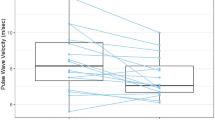Abstract
Background
Hiking is one of the most popular activities among the elderly in Alpine regions. Due to the long-lasting, moderately intensive nature of this form of physical activity, hiking is generally considered to be beneficial to health. However, it is currently unclear whether once-weekly hiking—as commonly practiced at weekends—really does yield such positive effects in elderly persons aged 60 years and over.
Objectives
This study investigated the effect of a single weekly mountain hiking session on cardiovascular risk factors.
Materials and methods
A 9-month mountain hiking program was completed by 14 male (age 65.6 ± 2.7 years) and 10 female (age 66.2 ± 4.4 years) elderly participants. The program consisted of a single weekly hiking session with the goal of achieving a 500-m altitude increase within 3 h. Before and after the 9-month program, an electrocardiogram (ECG) was performed and blood pressure, glycated hemoglobin (HbA1c), high-density (HDL) and low-density lipoprotein (LDL) measurements were made.
Results
The elderly participants showed a normal cardiovascular risk profile at the start of the investigation. The estimated net energy expenditure for one hiking session was approximately 521 ± 91 kcal. Over the 9-month period, no changes were found in any of the investigated parameters for the entire group. However, participants with untreated hypertension showed a reduced systolic blood pressure.
Conclusion
The present investigation showed that moderate-intensity activity only at weekends does not improve cardiovascular risk factors in elderly persons with a relatively normal cardiovascular risk profile. Conversely, elderly persons suffering from hypertension might profit from such a practice.
Zusammenfassung
Hintergrund
Im alpinen Raum zählt Wandern bei älteren Menschen zu den beliebtesten Aktivitäten. Aufgrund der länger andauernden, körperlichen Aktivität mit moderater Intensität werden dem Wandern positive gesundheitliche Effekte zugeschrieben. Jedoch ist unklar, ob 1-mal Wandern pro Woche, wie es häufig an den Wochenenden praktiziert wird, diese positiven Effekte hervorruft.
Ziel
Ziel dieser Studie war es, die Auswirkungen einer Wandereinheit pro Woche auf kardiovaskuläre Risikofaktoren zu untersuchen.
Material und Methoden
An dem Wanderprogramm, das sich über einen Zeitraum von 9 Monaten erstreckte, nahmen 10 weibliche (Alter: 66,2 ± 4,4 Jahre) und 14 männliche (Alter: 65,6 ± 2,7 Jahre) ältere Menschen teil. Das wöchentliche Wanderprogramm beinhaltete einen Aufstieg von 500 Höhenmetern 1-mal pro Woche innerhalb von 3 Stunden. Vor und nach den 9 Monaten wurden ein EKG aufgezeichnet, der Blutdruck gemessen und HbA1c-, HDL- und LDL-Werte bestimmt.
Ergebnisse
Zu Beginn der Untersuchung lag das kardiovaskuläre Risikoprofil der Teilnehmer durchweg im Normalbereich. Der Energieverbrauch während der Wandereinheit betrug durchschnittlich 521 ± 91 kcal. In der Gesamtgruppe konnten keine Veränderungen der erhobenen Risikoparameter gefunden werden. Jedoch zeigte sich, dass Teilnehmer mit unbehandeltem Bluthochdruck eine Reduktion des systolischen Blutdrucks erfuhren.
Schlussfolgerung
Bei älteren Personen mit einem relativ normalen kardiovaskulären Risikoprofil dürfte Bergwandern, an einem Tag in der Woche, keinen Effekt auf kardiovaskuläre Risikofaktoren haben. Andererseits zeigte sich, dass ältere Personen mit Bluthochdruck von den wöchentlichen Wandereinheiten profitieren können.
Similar content being viewed by others
References
American College of Sports Medicine (2010) Guidelines for exercise testing and prescription, 8th edn. Lippincott Williams & Wilkinson, Philadelphia
Blair SN, Kampert JB, Kohl HW et al (1996) Influences of cardiorespiratory fitness and other precursors on cardiovascular disease and all-cause mortality in men and women. JAMA 276:205–210
Burtscher M (2004) Endurance performance of the elderly mountaineer: requirements, limitations, testing, and training. Wien Klin Wochenschr 116:703–714
Burtscher M, Gatterer H, Kunczicky H et al (2009) Supervised exercise in patients with impaired fasting glucose: impact on exercise capacity. Clin J Sport Med 19:394–398
Burtscher M, Philadelphy M, Likar R (1993) Sudden cardiac death during mountain hiking and downhill skiing. N Engl J Med 329:1738–1739
Faulhaber M, Flatz M, Gatterer H et al (2007) Prevalence of cardiovascular diseases among alpine skiers and hikers in the Austrian Alps. High Alt Med Biol 8:245–252
Greie S, Humpeler E, Gunga HC et al (2006) Improvement of metabolic syndrome markers through altitude specific hiking vacations. J Endocrinol Invest 29:497–504
Kohl HW, Fitzgerald SJ, Willis BL et al (2009) Weekend warriors and cardiorespiratory fitness: is it frequency or intensity? Med Sci Sports Exerc 41(Suppl 1):146
Lee IM, Sesso HD, Oguma Y et al (2004) The “Weekend Warrior” and risk of mortality. Am J Epidemiol 160:636–641
Meyer T, Auracher M, Heeg K et al (2006) Does cumulating endurance training at the weekends impair training effectiveness? Eur J Cardiovasc Prev Rehabil 13:578–584
Minetti AE (1995) Optimum gradient of mountain paths. J Appl Physiol 79:1698–1703
Myers J, Kaykha A, George S et al (2004) Fitness versus physical activity patterns in predicting mortality in men. Am J Med 117:912–918
Oster P, Pfister M, Schuler M et al (2005) Körperliches Training im Alter. Z Gerontol Geriat 38(Suppl 1):I/10–I/13
Powell KE, Paluch AE, Blair EN (2011) Physical activity for health: what kind? How much? How intense? On top of what? Annu Rev Public Health 32:349–365
Schobersberger W, Leichtfried V, Mueck-Weymann M et al (2010) Austrian Moderate Altitude Studies (AMAS): benefits of exposure to moderate altitudes (1,500–2,500 m). Sleep Breath 14:201–207
Wasserman K, Hansen, Sue et al (2005) Principles of exercise testing and interpretation: including pathophysiology and clinical applications, 4th edn. Lippincott Williams & Wilkinson, Philadelphia
Compliance with ethical guidelines
Conflict of interest. H. Gatterer, C. Raab, S. Pramsohler, M. Faulhaber, M. Burtscher and N. Netzer state that there are no conflicts of interest. All studies on humans described in the present manuscript were carried out with the approval of the responsible ethics committee and in accordance with national law and the Helsinki Declaration of 1975 (in its current, revised form). Informed consent was obtained from all patients included in studies.
Author information
Authors and Affiliations
Corresponding author
Rights and permissions
About this article
Cite this article
Gatterer, H., Raab, C., Pramsohler, S. et al. Effect of weekly hiking on cardiovascular risk factors in the elderly. Z Gerontol Geriat 48, 150–153 (2015). https://doi.org/10.1007/s00391-014-0622-0
Published:
Issue Date:
DOI: https://doi.org/10.1007/s00391-014-0622-0




